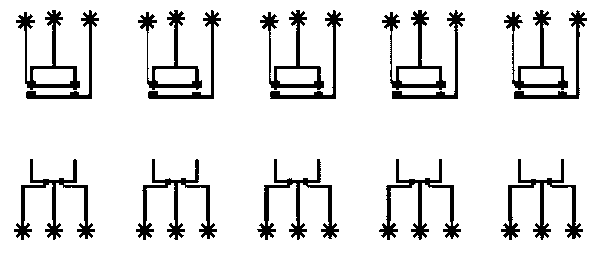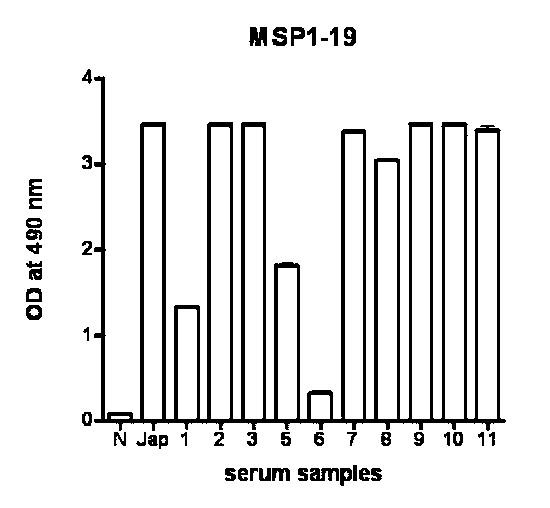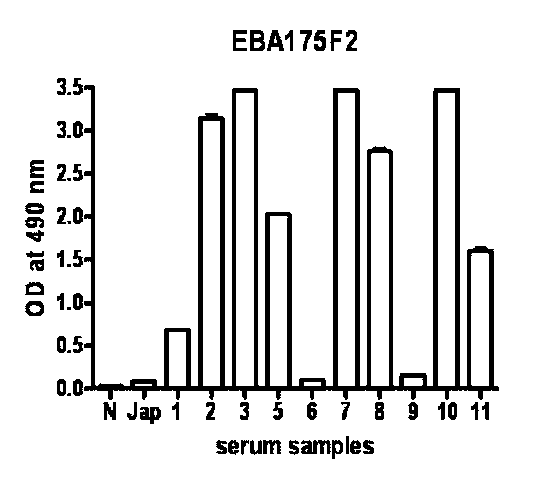High-flux rapid malaria serum detection method based on micro-fluidic chip
A microfluidic chip and high-throughput technology, applied in the field of biomedicine, can solve the problems of low degree of automation, inability to distinguish Plasmodium species, and easy cross-contamination, so as to shorten the inspection time, improve the detection accuracy, The effect of reducing inspection costs
- Summary
- Abstract
- Description
- Claims
- Application Information
AI Technical Summary
Problems solved by technology
Method used
Image
Examples
Embodiment 1
[0036] Example 1 Preparation of microfluidic chip
[0037]Put the silicon wafer into Piranha solution (98% concentrated sulfuric acid: 30% hydrogen peroxide = 7:3), boil and clean for 15 minutes; rinse it with deionized water for 5 times, dry it with nitrogen, and bake it at 200 °C for 30 minutes; Pour the SU-8 glue on the center of the silicon wafer and rotate it slowly so that the SU-8 covers most of the silicon wafer; use a spin coater at 3000 rpm for 60s to make the glue evenly distributed, and let it stand for 10 minutes to relieve edge protrusions effect; followed by soft baking, the purpose of soft baking is to volatilize the solvent in the SU-8 photoresist, the key to process control is to make the solvent volatilize at a controllable rate; keep the temperature at 65°C, 95°C and 65°C, respectively 3min, 6min and 3min. After that, the temperature was slowly lowered to room temperature at a rate of 0.5°C / min; a contact exposure machine (wavelength 365nm) was used; pos...
Embodiment 2
[0038] Example 2 Detection of serum from malaria patients by enzyme-linked immunosorbent assay (ELISA)
[0039] 100 μl of Coating Buffer containing 100 ng of Plasmodium protein merozoite surface antigen 1 (MSP1) and erythrocyte-binding antigen 175 (EBA175) were added to each well of a 96-well microtiter plate, and the cells were placed in a humidified box at 4°C overnight. After washing the plate with PBS (containing 0.05% Tween20), 400 μl of PBS containing 3% skim milk was added to each well, and the plate was blocked at room temperature for 1 h in a humidified box. 100 μl of healthy human or patient serum (1:400 dilution) was added to each well, and the negative control was healthy human serum (1:400 dilution) and incubated at room temperature for 1 h in a humidified box. After washing the plate with PBS (containing 0.05% Tween20), add 100 μl horseradish peroxidase-labeled goat anti-human IgG (1:1000 dilution) 100 μl to each well, and incubate in a humid box for 1 h at roo...
Embodiment 3
[0041] Example 3 Serological detection of malaria patients with microfluidic chip
[0042] Fill the column with polymeric fillers through the injection channel, close the valve at the bottom of the column, control the air pressure of the valve not to exceed 20 psi, and control the speed of the column. After the analysis chamber of the chip, after several times of PBS washing, several filler volumes of recombinant Plasmodium MSP1 and EBA175 antigen solutions were pumped into different analysis chambers, and through specific binding, the Plasmodium protein antigen and the polymerized microspheres were formed. Filler binding. After several PBS washes, PBS containing 5% bovine albumin was pumped into the microfluidic chip analysis chamber to block the polymerized microspheres bound to recombinant Plasmodium antigens. The serum of malaria patients was then diluted and pumped into the analysis chamber of the microfluidic chip, and the anti-plasma parasite MSP1 and EBA175 antibodi...
PUM
 Login to View More
Login to View More Abstract
Description
Claims
Application Information
 Login to View More
Login to View More - R&D
- Intellectual Property
- Life Sciences
- Materials
- Tech Scout
- Unparalleled Data Quality
- Higher Quality Content
- 60% Fewer Hallucinations
Browse by: Latest US Patents, China's latest patents, Technical Efficacy Thesaurus, Application Domain, Technology Topic, Popular Technical Reports.
© 2025 PatSnap. All rights reserved.Legal|Privacy policy|Modern Slavery Act Transparency Statement|Sitemap|About US| Contact US: help@patsnap.com



